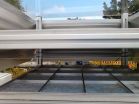(Press-News.org) BOSTON, Aug.17, 2015 -- In a first-of-its-kind study, researchers have determined that natural sunlight triggers the release of smog-forming nitrogen oxide compounds from the grime that typically coats buildings, statues and other outdoor surfaces in urban areas. The finding confirms previous laboratory work using simulated sunlight and upends the long-held notion that nitrates in urban grime are "locked" in place.
The scientists will present their findings based on field studies conducted in Leipzig, Germany, and Toronto, Canada, at the 250th National Meeting & Exposition of the American Chemical Society (ACS), the world's largest scientific society. The meeting features more than 9,000 reports and is being held here through Thursday.
"The current understanding of urban air pollution does not include the recycling of nitrogen oxides and potentially other compounds from building surfaces," says James Donaldson, Ph.D. "But based on our field studies in a real-world environment, this is happening. We don't know yet to what extent this is occurring, but it may be quite a significant, and unaccounted for, contributor to air pollution in cities."
Urban grime, according to Donaldson, is a mixture of thousands of chemical compounds spewed into the air by automobiles, factories and a host of other sources. Among these compounds are nitrogen oxides. When in the air, these compounds may combine with other air pollutants -- known as volatile organic compounds -- to produce ozone, which is the main component of smog. But scientists had long suspected that nitrogen oxides become inactive when they are trapped in grime and settle on a surface.
However, Donaldson and his colleagues at the University of Toronto have collected data that are inconsistent with this theory. In previous work, they discovered that nitrate anions disappeared from grime at faster rates than could be explained by wash-off due to rainfall. And, in a subsequent laboratory comparison, they found that nitrate disappeared from grime 10,000 times faster than from a water-based solution when both were exposed to artificial sunlight. In yet another study, they exposed grime to either artificial sunlight or kept it in the dark. The grime exposed to a "solar simulator" shed more nitrates than the grime left in the dark, suggesting that light can chemically convert nitrogen compounds back into active forms that can return to the atmosphere.
Intrigued, Donaldson set out to test this concept in the real world. Working with colleagues in Germany, he set up a six-week field study in Leipzig and a similar year-long study in Toronto. The researchers placed grime collectors containing glass beads throughout both cities. The beads create more surface area for grime to gather on than a flat surface, such as a window.
Some of the collection devices were left in the sun; others were intentionally put in the shade, but had adequate air flow so that grime could collect on their surfaces. The Toronto study is ongoing and the data are still being analyzed. But in Leipzig, the researchers found that grime in shaded areas contained 10 percent more nitrates than grime exposed to natural sunlight, which was consistent with the team's laboratory findings.
"If our suspicions are correct, it means that the current understanding of urban air pollution is missing a big chunk of information," Donaldson says. "In our work, we are showing that there is the potential for significant recycling of nitrogen oxides into the atmosphere from grime, which could give rise to greater ozone creation."
Interestingly, Donaldson notes that Leipzig has far more grime than Toronto, based on the amount of material gathered at collection stations in both cities so far. This difference could have a significant influence on the city's air quality. "The fact that Leipzig appears to have 20 times more grime than Toronto suggests that there is a potential for 20 times more recycling of nitrogen oxides into the local atmosphere," Donaldson says.
To test this idea, his team hopes to conduct field experiments in someplace that is "really grubby" and someplace that is "really clean." They also plan to examine the effects of humidity, grime levels and various amounts of illumination on the recycling of nitrates back into the atmosphere.
INFORMATION:
A press conference on this topic will be held Monday, Aug. 17, at 1:30 p.m. Eastern time in the Boston Convention & Exhibition Center. Reporters may check-in at Room 153B in person, or watch live on YouTube http://bit.ly/ACSLiveBoston. To ask questions online, sign in with a Google account.
The American Chemical Society is a nonprofit organization chartered by the U.S. Congress. With more than 158,000 members, ACS is the world's largest scientific society and a global leader in providing access to chemistry-related research through its multiple databases, peer-reviewed journals and scientific conferences. Its main offices are in Washington, D.C., and Columbus, Ohio.
To automatically receive news releases from the American Chemical Society, contact newsroom@acs.org.
Note to journalists: Please report that this research was presented at a meeting of the American Chemical Society.
Follow us: Twitter | Facebook
Title
Composition and chemistry of urban grime: A field and laboratory study
Abstract
Stationary surfaces in urban environments that are exposed to the atmosphere accumulate a deposit ("urban grime") over time by accretion of gas-phase compounds and particulate matter. Thus, over time, exposed surfaces become chemically quite different from the substrates initially present. In spite of the ubiquitous nature of such coatings, there have been few reports on their chemical composition and almost nothing is known about the way(s) in which they may influence heterogeneous chemistry. We report results from a campaign in which we: (a) compare the grime composition to that of particles collected contemporaneously during the autumn of 2014 in Leipzig, Germany; (b) monitor seasonal changes in grime composition and water uptake ability over a 12 month period in Toronto, Canada; (c) establish the NOx recycling ability of urban grime, both from field measurements and from laboratory studies of illuminated real grime samples.
New Internet-based technology may aid criminal justice agencies through tools such as better criminal databases, remotely conducted criminal trials and electronic monitoring of parolees in the community, according to a new RAND Corporation study.
Top criminal justice priorities for new Internet tools include developing a common criminal history record that can be shared across agencies, developing real-time language translation tools and improved video displays for law enforcement officers to adapt to changing needs, according to the analysis.
"The criminal justice ...
During the deer's breeding season, or rut, the researchers from Queen Mary University of London (QMUL) and ETH Zürich, played male fallow deer (bucks) in Petworth Park in West Sussex, a variety of different calls that had been digitally manipulated to change the pitch and length and analysed their responses. The bucks treated lower pitched and longer calls as more threatening, by looking towards source of the call sooner and for longer, than others.
Fallow bucks attracted the attention of the researchers because of their intriguing calling behaviour. Males are silent ...
BOSTON, Aug. 16, 2015 -- Sunlight can be brutal. It wears down even the strongest structures, including rooftops and naval ships, and it heats up metal slides and bleachers until they're too hot to use. To fend off damage and heat from the sun's harsh rays, scientists have developed a new, environmentally friendly paint out of glass that bounces sunlight off metal surfaces -- keeping them cool and durable.
The researchers present their work today at the 250th National Meeting & Exposition of the American Chemical Society (ACS). ACS, the world's largest scientific ...
Findings from Nationwide Children's Hospital physicians demonstrate that headaches increase in fall in children, a trend that may be due to back-to-school changes in stress, routines and sleep. Although it may be difficult for parents to decipher a real headache from a child just wanting to hold onto summer a little longer and avoid going back to school, there is a variety of other common triggers including poor hydration and prolonged screen time that could contribute to a child's discomfort.
"When we saw many of our families and patients in clinic, the families would ...
BUFFALO, N.Y. - Medicare Part D provides help to beneficiaries struggling with the cost of prescriptions drugs, but the plan's coverage gap hits some populations harder than others, particularly African-Americans age 65 and older. Reaching, or even approaching, the gap affects access to medication and influences whether those medications are taken as prescribed.
"Don't assume that the existence of Part D means that people aren't having a difficult time affording their meds," says Louanne Bakk, an assistant professor in the University at Buffalo School of Social Work. "There ...
SALT LAKE CITY, Aug. 14, 2015 - Software may appear to operate without bias because it strictly uses computer code to reach conclusions. That's why many companies use algorithms to help weed out job applicants when hiring for a new position.
But a team of computer scientists from the University of Utah, University of Arizona and Haverford College in Pennsylvania have discovered a way to find out if an algorithm used for hiring decisions, loan approvals and comparably weighty tasks could be biased like a human being.
The researchers, led by Suresh Venkatasubramanian, ...
Discovered in 1982, Helicobacter pylori (H. pylori) is a disease-causing bacterium that survives in our stomachs despite the harsh acidic conditions. It is estimated that one in two people have got it, though most won't ever experience any problems. Even so, it is considered one of the most common bacterial infections worldwide and a leading cause of dyspepsia, peptic ulceration and gastric cancer.
Through unique evolutionary adaptations, H. pylori is able to evade the antiseptic effect of our stomach acid by hiding within the thick acid-resistant layer of mucus that ...
Washington, DC - August 14, 2015 - Tungsten is exceptionally rare in biological systems. Thus, it came as a huge surprise to Michael Adams, PhD., and his collaborators when they discovered it in what appeared to be a novel enzyme in the hot spring-inhabiting bacterium, Caldicellulosiruptor bescii. The researchers hypothesized that this new tungstoenzyme plays a key role in C. bescii's primary metabolism, and its ability to convert plant biomass to simple fermentable sugars. This discovery could ultimately lead to commercially viable conversion of cellulosic (woody) biomass ...
What happens when a drought in Florida estuaries causes a rise in the salt levels in water? Fewer wild oysters appear on restaurant menus, for starters.
New research from Northeastern University marine and environmental sciences professor David Kimbro and graduate student Hanna Garland, published in PLOS ONE, links the deterioration of oyster reefs in Florida's Matanzas River Estuary (MRE) to a population outbreak of carnivorous conchs and ...
OAK RIDGE, Tenn., Aug. 14, 2015 - Another barrier to commercially viable biofuels from sources other than corn has fallen with the engineering of a microbe that improves isobutanol yields by a factor of 10.
The finding of the Department of Energy's BioEnergy Science Center, published in the journal Metabolic Engineering, builds on results from 2011 in which researchers reported on the first genetically engineered microbe to produce isobutanol directly from cellulose.
Isobutanol is attractive because its energy density and octane values are much closer to gasoline and ...



